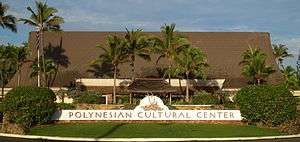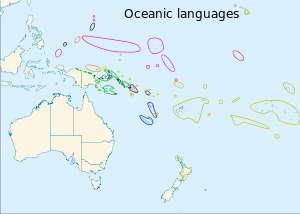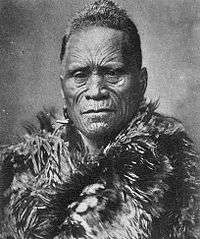Mormonism and Pacific Islanders

Relations between The Church of Jesus Christ of Latter-day Saints (LDS Church) and the natives of the Pacific Island groups of Polynesia, Melanesia, Micronesia and surrounding island groups are quite complex.
History

The Pacific islands were one of the first areas to be evangelised after Europe and North America, notably Hawaii, which fell under American influence and was annexed by the USA quite early on.
On November 27, 1919 Laie Hawaii Temple was the first temple outside continental United States, and thus also arguably first outside North America and first in Polynesia.
In 1955, the church began ordaining Melanesians to the Priesthood, and on September 26, Church College of Hawaii established.
The church had always allowed Pacific Islanders to hold the priesthood, and President McKay clarified that black Fijians and Australian Aborigines could also be ordained to the priesthood.
Book of Mormon translations

- 1855, the Hawaiian language translation of the Book of Mormon was the first in a non-European language.
- 1889: Māori edition.
- 1903: Samoan edition.
- 1904: Tahitian edition.
- 1946: Tongan edition.
- 1965: Rarotongan edition.
- 1980: Fijian edition.
- 1981: Niuean edition (selections)
- 1987: Trukese, Micronesian languages.
- 1988: Palauan edition.
- 1989: Chamorro edition.
- 1990s: various Philippines languages.
- 2001: Gilbertese (Kiribati) edition.
- 2002: Tok Pisin edition.
- 2003: Marshallese edition.
- 2004: Bislama edition.
- 2004: Yapese edition.
Hagoth
In addition to the Mormon stories about people sailing to the New World, there is also the story of Hagoth, who it is alleged sailed from the Americas to Polynesia. But while the stories of Lehi and Jared are generally accepted, that of Hagoth is more ambiguous and not universally supported by practising Mormons, and not at all by non-members of that church. Differentiating between scriptural and apocryphal accounts of Hagoth and his ships, one Mormon writer makes the following observations:
The Book of Mormon does not equate the “west sea” with the Pacific Ocean. The Book of Mormon does not tell us that Hagoth was on board any of the ships that were lost. Scripture does not say that he captained a vessel or that he was an explorer or an adventurer, or that he led people. For all we can tell, the skilled Hagoth’s main objective was to profit from the shipping industry. It is possible for peoples in various places to be related to Hagoth’s people (the Nephites) without Hagoth personally making an ocean voyage. Coastal and Island hopping colonies, once associated with Nephite shipping, could have built more vessels and traveled very far. It is also important to realize that the peoples of the Pacific islands may have come from more than one direction.[1]
Non-scriptural sources suggest that Hagoth led an expedition, sailing into the Pacific Ocean from the Americas. Leaders of the Church of Jesus Christ of Latter-day Saints[2][3] and scholars have stated that the peoples of the Pacific Islands, including Hawaii, Polynesia, and New Zealand, are descendants of the Nephite Hagoth and his supposed followers.[4] According to the Book of Mormon, the Nephites were descendants of Israel. Many rank and file members of the LDS Church in Polynesia have come to believe that Hagoth is their ancestor.[5]
Folklore
- that Tāwhiao accurately predicted the site of the 1958 Hamilton New Zealand Temple before his death in 1894;[6][7]
- that Māori prophets or chieftains, including Paora Te Potangaroa and Tāwhiao, predicted the coming of Mormon missionaries to New Zealand;[8][9][10]
- that on December 7, 1941, Japanese aircraft pilots attempted to bomb or strafe the church's Laie Hawaii Temple just prior to or just after the attack on Pearl Harbor, but were prevented from doing so by mechanical failures or an unseen protective force,[11] and that the Japanese pilot who attempted to bomb or strafe the Laie Hawaii Temple was converted to the LDS Church after he saw a picture of the temple in the possession of Mormon missionaries in Japan;[11]
Portrayals in media
- Johnny Lingo
- The Other Side of Heaven
- The Legend of Johnny Lingo, a remake of the 1968 film.
Notable Pacific Islander Mormons
Church members from indigenous groups:
- Princess 'Elisiva Fusipala Vaha'i
- Saimoni Tamani
- Sid Going, All Blacks captain, and player for NZ Maori.
- Brendon Pongia
- Naomi Kahoilua Wilson
- Jonah Lomu, joined the Church in 2012, 3 years before his passing
- Ken Niumatalolo, Coach of the Navy Midshipmen football team
- Kilani Sitake, Coach of the Brigham Young University Cougars football team
References
- ↑ Coon, W. Vincent, Q & A, “Hagoth’s Lost Ships!”; additionally, Coon notes that the scriptural use of the term “curious” may mean “accomplished with skill and ingenuity” and does not necessarily imply an inclination for adventure.
- ↑ R. Lanier Britsch stated in the New Era, "Since the days of George Q. Cannon in Hawaii (1851–54), the Church leaders had more and more frequently alluded to the idea that the Polynesians were descendants of Lehi, the early Book Of Mormon prophet. Although the relationship between the Polynesian peoples and the alleged “adventurer” Hagoth (see Alma 63:5–8) is not clear—he being a Nephite and the Polynesians appearing to be Lamanites—Church leaders have time and time again referred to the Polynesians as children of Lehi." - R. Lanier Britsch, "Maori Traditions and the Mormon Church", New Era, June 1981.
- ↑ The Church of Jesus Christ of Latter-day Saints' Book of Mormon Seminary Student Study Guide
- ↑ http://www.ldsces.org/inst_manuals/bm-in-sm1996/manualindex.asp
- ↑ For one Mormon artist'ss portrayal of Polynesian people as the "Children of Hagoth", see "A Worldwide Look at the Book of Mormon, Liahona, December 2000. For an example of Hagoth being regarded as a "hero" by Polynesian Mormon youth, see Kathleen C. Perrin, “Tahitian Pearls,”, Liahona, June 1994.
- ↑ LDS Church (1958), The Mormon Temple, Temple View, Hamilton, New Zealand: Bureau of Information, Zealand Temple, LDS Church, p. 13, OCLC 367545393, alt. OCLC 156001909
- ↑ Kezerian, Sandra L. (March 31, 2012), "Visiting our Family History Missionaries at the Archives", WellingtonNewZealandMission.blogspot.com
- ↑ Matthew Cowley, ""Maori Chief Predicts Coming of L.D.S. Missionaries", Improvement Era 53:696–698, 754–756 (Sep. 1950), reprinted in Matthew Cowley (1954, Glen L. Rudd ed.). Matthew Cowley Speaks: Discourses of Elder Matthew Cowley of the Quorum of the Twelve Apostles of the Church of Jesus Christ of Latter-day Saints (Salt Lake City, Utah: Deseret Book) p. 200–205.
- ↑ Grant Underwood, "Mormonism and the Shaping of Maori Religious Identity", in Grant Underwood (ed.) (2000). Voyages of Faith: Explorations in Mormon Pacific History (Provo, Utah: Brigham Young University) pp. 107–126.
- ↑ R. Lanier Britsch, “Maori Traditions and the Mormon Church,” New Era, June 1981, p. 38.
- 1 2 Kenneth W. Baldridge and Lance D. Chase, "The Purported December 7, 1941, Attack on the Hawai'i Temple", in Grant Underwood (ed.) (2000). Voyages of Faith: Explorations in Mormon Pacific History (Provo, Utah: Brigham Young University Press) ISBN 0-8425-2480-0, pp. 165–190.

.jpg)